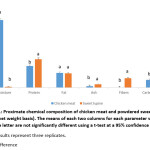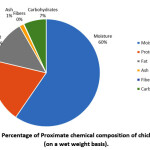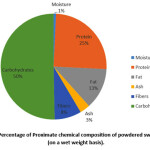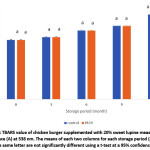Introduction
Chicken meat, which is classified as white meat, is differentiated by its lower iron level than lamb and beat meats, which have around three times the iron content of the former. Although not all meat is considered nutritious, white chicken meat is, and it is also more affordable. Because it is low in saturated fats and high in several vital nutrients, chicken meat, whether processed or not, is healthier than red meat when consumed in great amounts, such as more than 500g per week 1,2. Chicken meat has become more popular in recent years with its great nutritional content. It has a high protein content (20g/100g skinned meat) as well as a low-fat content (5g/100g skinned meat). It also includes a high percentage of unsaturated fatty acids (polyunsaturated fatty acids), which have a beneficial effect on consumers’ health 3. Chicken meat is appropriate for processing because of its soft texture and desirable flavor, which is required for marketing and for both children and adults. Frozen burgers, patties, sausages, loaves, and meatballs contain minced chicken meat. Chicken might also be offered whole, such as wings and drumsticks, as well as marinated or injected fillets. On the other hand, cooked breaded patties and nuggets are the most popular ready-to-cook chicken goods available in markets 4.
Also, according to Petracci et al., 5 chicken and beef collagen derivatives are among the most widely accessible on the market, with varying degrees of usefulness and purity. Meanwhile, beef meat was used in a large number of processed items since its protein was more functional (such as gelling ability) than chicken protein, and it was also more costly. Such factors explain why beef collagen derivatives are chosen over poultry collagen derivatives in many poultry items. The aforementioned response was in reference to the capacity to swell in hot or cold temperatures. Sweet lupine is a leguminous bean of the Fabaceae family. It is a good source of protein that many individuals include in their diet 6,7. The use of lupine protein in food technology has been limited due to a lack of accessible knowledge on its functional qualities, which play an important role in the behavior of proteins during processing or storage, as well as the quality of food recipes 8. In comparison to other legumes, lupine has a higher level of phytochemicals with antioxidant properties (polyphenols, primarily tannins, and flavonoids), as well as a lower content of undesired elements such as oligosaccharides, lectins, saponins, and trypsin inhibitors. Several quinolizidine alkaloids (e.g., lupineine, sparteine, lupineidine, anagirine, lupanine, hydroxy-lupanine, etc.) were discovered 1,9-12 .The aim of this study is to explore the prospect of employing powdered sweet lupine as a supplement for generating functional chicken burgers.
Materials and Methods
Minced chicken mothers’ meat was prepared using a meat mincer. Powdered sweet lupine seeds (Lupineus albus L) were also prepared using a custom electric mill at fodder to be a fine powder. Other raw ingredients used for making chicken burgers (onion, black pepper, red pepper, salt, and cubeb) were purchased from the local market at Al-karak governorate, Jordan.
Treatments
The chicken burger was made by applying the method of Danik et al., 13,using the following recipe given in Table (1). Burgers were placed in foam meat trays then all ingredients were mixed and formed using a manual burger press machine (Model Affettacarne NDAW, Italy). Recipes of chicken burgers supplemented with different ratios of powdered sweet lupine as well as their suggested names were shown in Table (2).
Table 1: Recipe for making 1 kg of the chicken burger as a control treatment
| Ingredient | Weight |
| Minced chicken meat | 900 |
| Onion | 75 |
| Black pepper | 5 |
| Red pepper | 5 |
| Salt (Na Cl) | 12.5 |
| Cubeb (allspice) | 2.5 |
Table 2: Recipes of chicken burgers supplemented with various ratios of powdered sweet lupine
| Ingredient (g) | Treatments* | |||
| C | LB10 | LB20 | LB35 | |
| Minced chicken meat | 900 | 810 | 720 | 525 |
| Powdered sweet lupine | – | 90 | 180 | 315 |
| Onion | 75 | 75 | 75 | 75 |
| Black Pepper | 5 | 5 | 5 | 5 |
| Red Pepper | 5 | 5 | 5 | 5 |
| Salt (Na Cl) | 12.5 | 12.5 | 12.5 | 12.5 |
| Cubeb (allspice) | 2.5 | 2.5 | 2.5 | 2.5 |
*C: Control (without powdered sweet lupine)
LB10: Supplemented burger with 10% sweet lupine
LB20: Supplemented burger with 20% sweet lupine
LB35: Supplemented burger with 35% sweet lupine
All ingredients were formed as burger pieces (4.0g each), plastic foam meat trays, packed in polyethylene bags, and frozen that stored at– 18°C±1 for three months.
Analytical Methods
The proximate chemical composition; i.e., moisture, protein, fat (lupine only), ash, fibers, and carbohydrates) of either raw chicken meat or sweet lupine powder was determined by recommended methods in A.O.A.C. (2016). Meanwhile, the fat content of burgers was determined using Sukhija et al., 14,15 method. Total carbohydrates were calculated as Total carbohydrates = 100 – (% moisture + % protein +% fat+ % ash). The Thiobarbituric acid (TBA) value was determined by the distillation method outlined by 16.
Detecting of amino acids profile of investigated samples was carried out using High-performance liquid chromatography (HPLC) 10 AVP, Shimadzu, Japan, at the Faculty of Pharmacy, Mutah University. For detecting fatty acids profile, Gas-liquid Chromatography (GLC) technique is available at the Faculty of Pharmacy, Mutah University. The caloric value of uncooked samples of chicken burgers was calculated on basis of a 100 g sample using the equation given by Mansour et al., 17 and by Unzil et al., 22, as Total calories (kcal/100g) =Fat× (9) +protein× (4.02) + carbohydrate × (3.87)
Sensory Evaluation
Grilled burger samples were evaluated for their sensory attributes (taste, texture, juiciness, and overall acceptability on 9 points hedonic scale then mean scores were statistically analyzed 18,19 .
Statistical Analysis
The obtained data were subjected to an analysis of variance (ANOVA) test and LSD was calculated at a 0.05 level of significance 20. The analysis was performed using SAS 9.4.
Results
Proximate Chemical; Composition
Figure 1, 2, and 3 shows the chemical composition of the employed raw material (chicken meat) and raw supplement (powdered sweet lupine). This table clearly shows that sweet lupine protein content was 1.3 times greater than chicken meat protein content. Meanwhile, fat content remained consistent (about 13 percent).
 |
Figure 1: Proximate chemical composition of chicken meat and powdered sweet lupine (on a wet weight basis). |
 |
Figure 2: Percentage of Proximate chemical composition of chicken meat (on a wet weight basis). |
 |
Figure 3: Percentage of Proximate chemical composition of powdered sweet lupine (on a wet weight basis). |
Organoleptic Evaluation of Treatments
Mean scores of investigated sensory attributes; i.e., taste, texture, juiciness as well as overall acceptability of suggested treatments. Means in each column followed with the same letter are not significantly different using Least Significant Differences at a 95% confidence level. The most favorite one was given in table (3).
Table 3: Mean scores of sensory attributes of various chicken burgers supplemented with sweet lupine during storage at -18°C.
| Storage period (month) | Taste± SE | Texture± SE | Juiciness± SE | Overall acceptability± SE | ||||||||
| LB10 | LB20 | LB35 | LB10 | LB20 | LB35 | LB10 | LB20 | LB35 | LB10 | LB20 | LB35 | |
| 0 | 8.40a*± 0.12 | 7.97a± 0.47 | 6.30a ± 0.03 | 7.15a± 0.09 | 8.09a± 0.60 |
5.45a± 0.03 | 7.50a± 0.12 | 7.30a± 0.09 | 6.45a± 0.06 | 6.95a± 0.02 | 8.00a± 0.07 | 5.80ab± 0.03 |
| 1 | 7.90b± 0.23 | 8.25a± 0.12 | 5.75b± 0.06 | 7.10a± 0.06 | 7.80a± 0.01 |
5.50a± 0.23 | 7.10 b± 0.06 | 6.90b± 0.11 | 5.75 b± 0.17 | 6.55b± 0.02 | 7.80a± 0.12 | 5.50b± 0.02 |
| 2 | 6.60c± 0.06 | 7.85a± 0.09 | 5.40c± 0.12 | 6.50b± 0.12 | 7.23ab± 0.04 |
5.40a± 0.11 | 6.25c± 0.07 | 6.00c± 0.14 | 5.40b± 0.16 | 6.15c± 0.01 | 7.35b± 0.09 | 5.85a± 0.01 |
| 3 | 6.35c± 0.09 | 7.75a± 0.14 | 4.50d± 0.03 | 5.25c± 0.14 | 6.25b± 0.09 | 4.44b± 0.13 | 5.50d± 0.14 | 5.00d± 0.06 | 4.15c± 0.07 | 5.62d± 0.03 | 6.70c± 0.01 | 4.70c± 0.20 |
*Means in each column followed with the same letter are not significantly different using Least Significant Differences at 95% confidence level.
**The results represent three replicates
Amino acids profile of (LB20) treatment
Table 4 indicates the amino acids profile of supplemented chicken burger with 20% powdered sweet lupine (LB20) compared with its un-supplemented one (control treatment). The predominated three amino acids could be in descending order glutamic acid (6.90%), aspartic acid (4.12%), and lysine (2.50%). While the corresponding findings in the control treatment were 5.25, 3.61, and 3.22%. When total amino acid was calculated, it was approximately the same (38.35% for LB20 vs 41.42% for control one). It means that adding 20% sweet lupine to the formula did not change the nutritional value of the product, but it did save 20% of the chicken meat used in production. Additionally, the two types of proteins (animal and plant proteins) were found together in the formula, lowering the product’s production costs and increasing its functional properties. The glutamic acid amino acid is the only one that has a concentration of more than 6%, followed by Aspartic acid (4.12%) and Arginine (3.37%).
Table 4: Amino acids % of chicken burger supplemented with 20% sweet lupine (LB20).
| Amino acid (A.A.)% | Control** ± SE | LB20 **± SE |
| Aspartic acid | 3.61b ± 0.02 | 4.12a ± 0.06 |
| Threonine* | 2.19a ± 0.03 | 1.73b ± 0.01 |
| Serine | 1.58a ± 0.01 | 1.75a ± 0.09 |
| Glutamic acid | 5.25b ± 0.03 | 6.90a ± 0.06 |
| Glycine | 2.66a ± 0.01 | 2.20b ± 0.03 |
| Alanine | 2.45a ± 0.01 | 1.99b ± 0.05 |
| Valine* | 2.18a ± 0.01 | 1.23b ± 0.01 |
| Isoleucine* | 2.00a ± 0.11 | 1.73a ± 0.04 |
| Leucine * | 3.14a ± 0.01 | 2.97b ± 0.02 |
| Tyrosine | 1.49b ± 0.01 | 1.70a ± 0.03 |
| phenylalanine* | 1.66a ± 0.01 | 1.61a ± 0.02 |
| Tryptophane* | 2.14a±0.03 | 1.28b± 0.03 |
| Histidine* | 2.08a ± 0.02 | 1.39b ± 0.01 |
| lysine* | 3.22a ± 0.02 | 2.50b ± 0.04 |
| Arginine | 3.20b ± 0.02 | 3.37a ± 0.02 |
| Proline | 2.91a ± 0.01 | 2.30b ± 0.02 |
| Cysteine | 2.70a ± 0.07 | 0.35b ± 0.01 |
| Methionine* | 1.10a ± 0.01 | 0.51b ± 0.02 |
| Total A.A.% | 45.56a ± 1.33 | 39.63b ± 1.18 |
| Total E.A.A% | 19.71a ± 077 | 14.95b ± 0.53 |
| Total E.A.A/ Total A.A ratio | 43.26a ± 0.12 | 37.72b ± 0.12 |
*Essential amino acid (E.A.A.)
**Means in each row with the same letter are not significantly different using t-test at 95% confidence level
*** The results represent three replicates.
Fatty acids profile of (LB20) treatment
Saturated fatty acids of the (LB20) treatment that is given in Table (5) showed six acids in either control or treated sample. C16:0 named palmitic acid came in the first order with 25.01 and 30.60%, respectively. In the second order, stearic acid C18:0 was coming with corresponding percentages of 6.32 and 8.06%. It means that supplementation with 20% powdered sweet lupine led to an increase in C16:0 and /or C18:0 by 1.22 and 1.28-fold, respectively, rather than those of their original values of un-supplemented one. By calculating the total saturated fatty acids (SFA) from the same table, it could be seen the same increasing fold that was found earlier, it was 1.25-fold. In addition, 76% of the total SFA of the LB20 sample was C16:0, meanwhile, the corresponding value of the control sample was 78%. It is of interest to notice that another predominant saturated fatty acid (C18:0) consists of 20% of total SFA in either the control sample or supplemented one.
Table 5: Saturated fatty acids (SFA) % of chicken burger supplemented with 20% sweet lupine (LB20)
| Fatty acid% | Control sample ± SE | LB20 Treatment ± SE |
| C14:0 | 0.55b ± 0.01 | 0.64a ± 0.02 |
| C15:0 | 0.10b ± 0.01 | 0.73a ± 0.02 |
| C16:0 | 25.01b ± 0.01 | 30.60a ± 0.02 |
| C17:0 | 0.10a ± 0.01 | 0.03b ± 0.02 |
| C18:0 | 6.32b ± 0.02 | 8.06a± 0.02 |
| C20:0 | 0.04b ± 0.01 | 0.19a ± 0.02 |
| Total SFA | 32.12b ± 0.07 | 40.25a ± 0.11 |
*Means in each row with the same letter are not significantly different using a t-test at a 95% confidence level
Regarding the other category of fatty acids; i.e., unsaturated ones (USFA), Table (6) indicated also six unsaturated fatty acids. The predominant one is oleic acid (C18:1) with a percentage of 44.04% in the treated sample higher than that of the untreated one (42.01%). With a contradicted pattern, linoleic acid (C18:2) came in the second order with 7.92% less than that detected in the untreated sample (19.09%) with 2.41-fold.
Table 6: Unsaturated fatty acids (USFA) % of chicken burger supplemented with 20% sweet lupine (LB20)
| Fatty acid% | Control sample ± SE | LB20 Treatment ± SE |
| C15:1 | 0.30*b ± 0.017 | 0.42a ± 0.01 |
| C16:1 | 5.02b ± 0.01 | 6.19a ± 0.01 |
| C18:1 | 42.01b ± 0.02 | 44.04a ± 0.02 |
| C18:2 | 19.09a ± 0.02 | 7.92b ± 0.01 |
| C18:3 | 1.01a ± 0.01 | 0.64b ± 0.02 |
| C20:1 | 0.22b ± 0.02 | 2.60a ± 0.02 |
| Total USFA | 67.65a ± 0.01 | 61.81b ± 0.00 |
| SFA /USFA ratio | 47.48b ± 0.05 | 65.12a ± 0.07 |
*Means in each row with the same letter are not significantly different using a t-test at a 95% confidence level.
Thiobarbituric acid (TBARS) of refrigerated stored chicken burger
TBARS value was followed through the refrigeration storage period of samples that extended to 12 day (Figure 4). The absorbance of the un-supplemented sample (control one) was ascendingly. increased during the refrigeration storage period. A similar pattern was also detected in the case of the (LB20) sample but with a very lower rate which means the supplementation process with sweet lupine led to a delay in the lipid oxidation of the suggested chicken burger.
 |
Figure 4: TBARS value of chicken burger supplemented with 20% sweet lupine measured as absorbance (A) at 538 nm. |
The caloric value of (LB20) treatment
The total calories (Kcal/100g) of the main ingredients used for preparing such chicken products (chicken meat and sweet lupine) should be compared either as raw materials or final products each other. Table (7) showed sweet lupine had a higher caloric value (410.7 Kcal/100g) rather than its corresponding value in chicken meat (220.5 kcal/100g). After processing of chicken burger by supplementing with 20% sweet lupine (LB20), the caloric value of resulted from the uncooked burger was minimized to 220.4 and 232.6/ kcal/100g for control and (LB20) samples, respectively. The sharp decreasing rate was detected in (LB20) sample (43.4%) compared to the slight one in the control (un-supplemented) sample (0.10%).
Table 7: Caloric value (Kcal/100g) of suggested.
| Sample | Caloric value | Decreasing rate % |
| Chicken meat | 220.5 | – |
| Sweet lupine | 410.7 | – |
| C* | 220.4 | 0.10 |
|
LB20* |
232.6 |
43.4 |
*See Table (2).
Discussion
The present study was conducted to explore the nutritional value of powdered sweet lupine as a supplement for generating functional chicken burgers. Sweet lupine has 2.5 times the amount of ash, while also having 55 times the number of fibers in meat burgers. Therefore, it plays a significant role as a good functional ingredient. The total carbohydrate content of sweet lupine was higher than that of chicken meat by about 75 folds. Statistically, data showed (LB20) treatment is the best one according to its four investigated sensory parameters (higher mean scores). These results are in agreement with those found by Lucas et al., 9 in the case of chicken nuggets supplemented with sweet lupine. She stated that supplementing chicken nuggets with sweet lupine affected the juiciness item; that is, the higher the supplementation ratio, the lower the juiciness score of chicken nuggets. This is due to the chemical makeup of sweet lupine, which caused the chicken burger recipe to absorb more water (moisture). As a result of the aforementioned sensory evaluation, (LB20) treatments were chosen as the study’s backbone; that is, to explore its quality attributes.
Regarding the other category of fatty acids; i.e., unsaturated ones (USFA). The predominant one is oleic acid (C18:1) with a percentage of 44.04% in the treated sample higher than that of the untreated one (42.01%). With a contradicted pattern, linoleic acid (C18:2) came in the second order with 7.92% less than that detected in the untreated sample (19.09%) with 2.41-fold. Meanwhile, the treated sample (LB20) had 1.05 times higher oleic acid (C18:1) rather than that found in the untreated one. Palmitoleic fatty acid (C16:1) was found in the third order with 5-6% in both of investigated samples either treated or not. Regarding the total USFA, supplementation with 20% powdered sweet lupine led to a decrease in such items by about 6% than that of the control sample. Therefore, (LB20) was less oxidized fat as seen when the TBARS test was measured. The ratio of SFA/USFA assured such a finding that was higher with 1.37-fold rather than that of the un-supplemented one 9.
After processing of chicken burger by supplementing it with 20% sweet lupine (LB20), the caloric value of resulted from the uncooked burger was minimized to 220.5 and 232.6/ kcal/100g for the control and (LB20) samples, respectively. The sharp decreasing rate was detected in (LB20) sample (43.36%) compared to the slight one in the control (un-supplemented) sample (0.06%). This is owing to both of higher caloric value of powdered sweet lupine and the higher ratio of supplementation. These findings go in parallel with those obtained by Abraham et al., 21.
Conclusion
Sweet lupine in conclusion was found to have higher fiber content that may have a beneficial effect on consumer’s health. The twenty percent addition of sweet lupine as a supplement to chicken burgers gave the best sensory properties and less oxidized fat as seen in when TBARS test. Rather than the multiple health properties of sweet lupine, it could reduce the cost of chicken burger production significantly.
Acknowledgement
The author is very thankful to all the associated personnel in any reference that contributed in/for the purpose of this research.
Conflict of Interest
The author declares that there is no conflict of interest.
Funding Sources
This research did not receive any specific grant from funding agencies in the public, commercial, or not-for-profit sectors.
References
- Kyriakopoulou K, Dekkers B, van der Goot AJ. Plant-based meat analogues. In: Sustainable meat production and processing. Elsevier; 2019:103-126.
CrossRef - Geiker NRW, Bertram HC, Mejborn H, et al. Meat and human health—Current knowledge and research gaps. Foods. 2021;10(7):1556.
CrossRef - Kralik G, Kralik Z, Grčević M, Hanžek D. Quality of chicken meat. Animal husbandry and nutrition. 2018;63.
CrossRef - Fletcher D. Further processing of poultry. Poultry meat processing and quality. 2004:108-134.
CrossRef - Petracci M, Bianchi M, Mudalal S, Cavani C. Functional ingredients for poultry meat products. Trends in food science & technology. 2013;33(1):27-39.
CrossRef - Faluyi M, Zhou X, Zhang F, Leibovitch S, Migner P, Smith D. Seed quality of sweet white lupin (Lupinus albus) and management practice in eastern Canada. European Journal of Agronomy. 2000;13(1):27-37.
CrossRef - Lo B, Kasapis S, Farahnaky A. Lupin protein: Isolation and techno-functional properties, a review. Food Hydrocolloids. 2021;112:106318.
CrossRef - Jayasena V, Chih HJ, Nasar-Abbas S. Functional properties of sweet lupin protein isolated and tested at various pH levels. Research Journal of Agriculture and Biological Sciences. 2010;6(2):130-137.
- Lucas MM, Stoddard FL, Annicchiarico P, et al. The future of lupin as a protein crop in Europe. Frontiers in plant science. 2015;6:705.
CrossRef - Arnold M, Rajagukguk YV, Gramza-Michałowska A. Functional food for elderly high in antioxidant and chicken eggshell calcium to reduce the risk of osteoporosis—a narrative review. Foods. 2021;10(3):656.
CrossRef - Haddad MA, Yamani MI, Da’san MM J, Obeidat M, Abu-Romman SM, Parisi S. Food Traceability in Jordan: Current Perspectives. Springer; 2021.
CrossRef - Lagana P, Coniglio MA, Fiorino M, et al. Phenolic substances in foods and anticarcinogenic properties: a public health perspective. Journal of AOAC International. 2020;103(4):935-939.
CrossRef - Martirosyan DM, Singh J. A new definition of functional food by FFC: what makes a new definition unique? Functional foods in health and disease. 2015;5(6):209-223.
CrossRef - Sukhija PS, Palmquist D. Rapid method for determination of total fatty acid content and composition of feedstuffs and feces. Journal of agricultural and food chemistry. 1988;36(6):1202-1206.
CrossRef - Bonoli M, Caboni MF, Rodriguez-Estrada MT, Lercker G. Effect of feeding fat sources on the quality and composition of lipids of precooked ready-to-eat fried chicken patties. Food Chemistry. 2007;101(4):1327-1337.
CrossRef - Abdeldaiem M. Use of yellow pigment extracted from turmeric (Curcuma longa) rhizomes powder as natural food preservative. American Journal of Food Science and Technology. 2014;2(1):36-47.
- Mansour EH, Khalil AH. Characteristics of low‐fat beefburgers as influenced by various types of wheat fibres. Journal of the Science of Food and Agriculture. 1999;79(4):493-498.
CrossRef - Lee S-H, Kim H-Y. Comparison of Quality and Sensory Characteristics of Spent Hen and Broiler in South Korea. Animals. 2021;11(9):2565.
CrossRef - Escobedo del Bosque CI, Grahl S, Nolte T, Mörlein D. Meat Quality Parameters, Sensory Properties and Consumer Acceptance of Chicken Meat from Dual-Purpose Crossbreeds Fed with Regional Faba Beans. Foods. 2022;11(8):1074.
CrossRef - McClave J, Benson P. Statistical for business and economics. Maxwell Macmillan International editions Dellen Publishing Co The USA. 1991;1991:272-295.
- Abraham S, O’Dea M, Sahibzada S, et al. Correction: Escherichia coli and Salmonella spp. isolated from Australian meat chickens remain susceptible to critically important antimicrobial agents. Plos one. 2020;15(1):e0227383.
CrossRef - Unzil NA, Azlan A, Sultana S. Proximate composition analysis of chicken burgers from night market stalls and selected fast-food restaurants. Food Research. 2021;5(1):471-477. doi:10.26656/fr.2017.5(1).469.
CrossRef

This work is licensed under a Creative Commons Attribution 4.0 International License.





